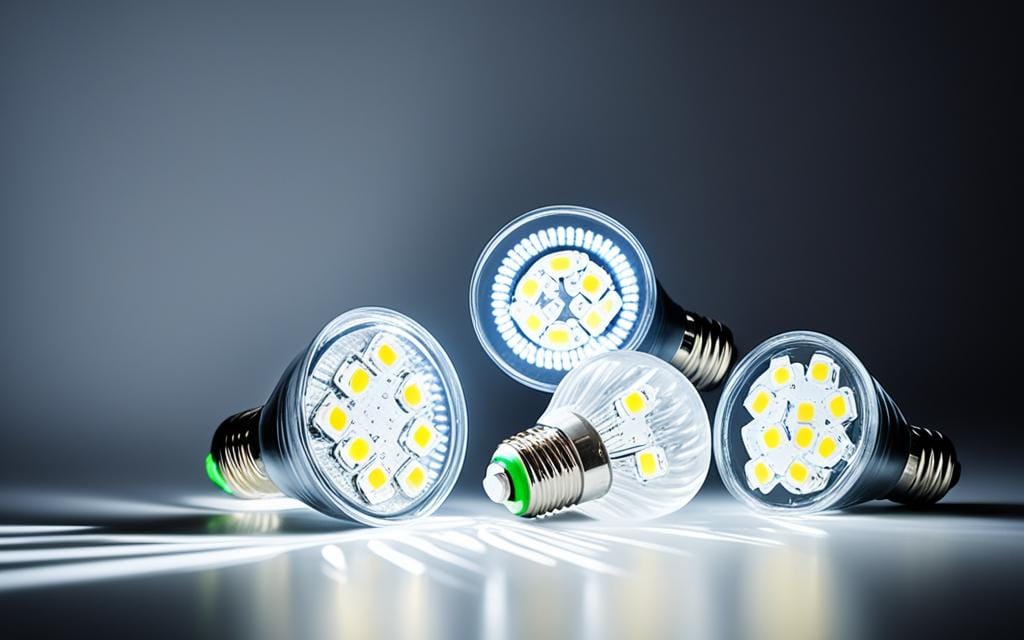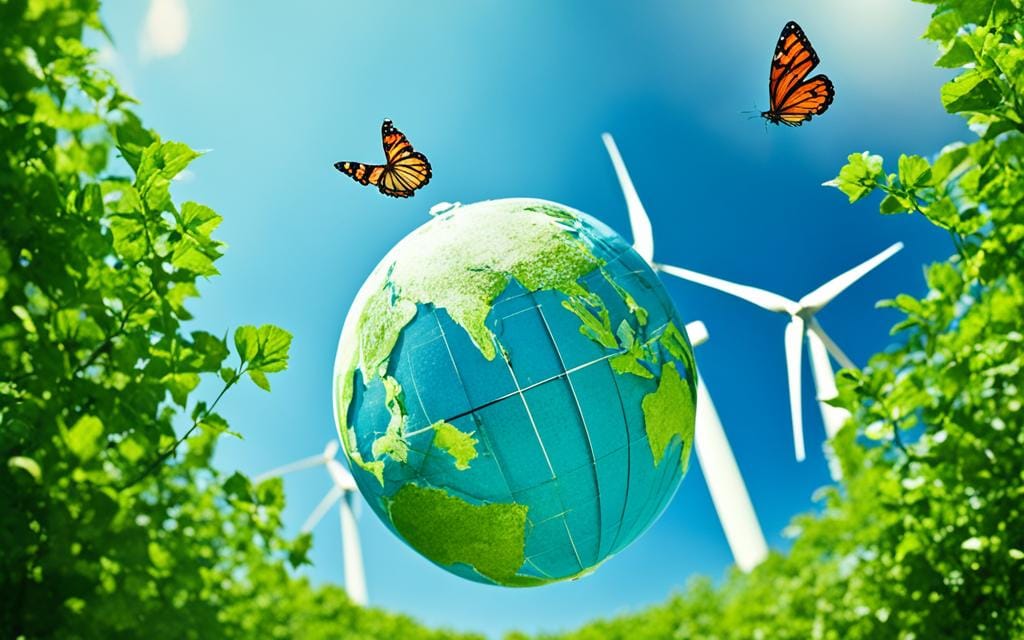How to Prevent Climate Change? The effects of climate change are already harming our lives and future. Our actions matter a lot, even more than you might think.
The average American makes four times the carbon emissions as the global average1. But if we all work together to lower our carbon footprints, we can help stop climate change. This article will show you some simple but powerful ways to protect our planet.
Table of Contents
ToggleSpeak Up and Make Your Voice Heard
To really make a difference in global climate change, we need to speak up2. Talking to our leaders can push them to make better laws on carbon and pollution2. We also need to tell our friends and family about these issues. It helps build support for fighting climate change3. Our leaders are more likely to act when they hear from us, their people2.
Reach Out to Elected Officials and Spread Awareness
When we want to share our thoughts on new rules or changes, we usually have at least 30 days2. At town hall meetings, we can talk right to the officials2. Bringing signs can help get our point across2. It’s good to work with others and plan what you want to say. This makes your message stronger2. Joining groups like NRDC gives us more chances to help, like by making calls or writing postcards2.
Many people in the world are looking for their governments to act on climate change3. People in developed countries are ready to make changes in their lives for the planet3. When we explain how humans are causing climate change, more people want quick action3. Young people worldwide are making a big difference in pushing for change3. But, wrong information makes things harder3.
Join the ActNow campaign and log when you speak up on a mobile app. Let’s add up our efforts across the globe4. It’s important to ask leaders to commit to the Paris Agreement and net-zero goals4. Cities are key, and we can ask them to aim for net-zero and join important climate groups4. We should also urge companies to set net-zero targets. This is very important for the planet4. Young people are already making a big impact by pushing their schools to be more eco-friendly4.
Faith groups are stepping up and reducing their own carbon footprints. It’s making a difference4. The music industry is also working harder to pollute less4. Where we put our money matters; choose banks and investments that care about the planet4. Talking with others is important too. It keeps us focused and motivated4. Start or join a group that works on climate issues. Together, we can do more4. Big companies changing how they operate is crucial for our climate future4.
Switch to Renewable Energy Sources
Moving to renewable energy is key in the battle against climate change. Currently, fossil fuels produce over 75% of greenhouse gases. They also make up almost 90% of carbon dioxide emitted5. Fortunately, wind and solar power are getting cheaper and more available. For instance, the cost of solar power fell by 85% from 2010 to 2020. Costs for wind energy (both onshore and offshore) dropped as well; 56% and 48% respectively5.
Right now, about 29% of our electricity comes from renewable sources5. But experts believe renewable energy could cover 90% of the electricity globally by 20505. Also, low-cost renewable energy could generate 65% of the world’s electricity by 2030. They predict that renewable energy could make 90% of electricity clean by 20505.
To help, we can pick a utility company that uses lots of wind or solar energy. They should be certified by Green-e Energy5. If that’s not possible, we can still show our support. We could do this by looking for renewable energy options on our utility bills or their website. Moving to clean energy could make more than 30 million jobs by 2030. To hit the goal of zero emissions by 2050, investing $4.5 trillion in renewable energy yearly is needed until 20305.
Last year, fossil fuels got $5.9 trillion in subsidies6. That’s around $11 billion daily. Plus, about $7 trillion goes to help fossil fuel companies every year5. By switching this money to renewable energy, we can speed up our move to a sustainable energy system. This change could lead to a healthier and fairer world for everyone.
| Metric | Current Status | Projected Future |
|---|---|---|
| Renewable Energy Share in Global Electricity Generation | 29%5 | 60% by 20306, 90% by 20505 |
| Fossil Fuel Subsidies | $5.9 trillion in 20206 | Shift subsidies towards renewable energy6 |
| Renewable Energy Job Creation | – | Over 30 million jobs by 20305 |
| Renewable Energy Investment Required | – | $4.5 trillion per year until 20305 |
Improve Home Energy Efficiency
Start at home to cut carbon. Nearly half our energy goes to heating and cooling. Making our home efficient matters8. Fix the drafts, upgrade your appliances, and you’ll see lower bills and a greener planet.
Weatherize Your Home
Seal your home to make it efficient. This means stopping drafts, adding insulation, and using tax credits for improvements8. An energy audit finds the best changes to make.
Invest in Energy-Efficient Appliances
Switch to Energy Star appliances for a big impact. They cut your carbon output and save you money8. These appliances need less energy, so they cost less to run and are better for the earth.
| Energy-Efficient Appliance | Average Annual Savings |
|---|---|
| Refrigerator | $50 |
| Washing Machine | $40 |
| Dishwasher | $30 |
| Dryer | $20 |
Make your home more efficient to slash carbon and expenses89. Find what can be better and commit to green living.
Conserve Water and Reduce Waste
Conserving water and reducing waste greatly help fight climate change. Water saving is key because large amounts of energy are needed for our water use. It’s also important to decrease food waste and use compost. This can cut down on the energy used in making and moving food, and less goes into landfills1011.
To save water, take shorter showers and turn off the tap when not in use. This habit alone can save more than 200 gallons every month. Also, using water-friendly products, like WaterSense-labeled toilets, can cut your home’s water use a lot10.
In the washing room, pick high-efficiency machines and choose water levels for your load size. For outdoor spaces, pick plants that don’t need too much water and avoid using systems that water on their own. Doing these things can greatly lessen the water you use1210.
Lessening waste is vital for a green life. By composting, you are keeping a lot of trash out of landfills, which then keeps greenhouse gases down. Fixing leaks, for example, in a toilet, can also save hundreds of gallons of water each day11.
| Water Conservation Strategies | Estimated Water Savings |
|---|---|
| Take shorter showers | 200 gallons per month10 |
| Install WaterSense-labeled toilets | Up to 60% water savings10 |
| Use high-efficiency washing machines | Significant water reduction12 |
| Implement climate-appropriate landscaping | Over 50% water savings10 |
| Repair leaks, such as a leaky toilet | Up to 200 gallons per day11 |
Following these strategies can help us lead more sustainable lives. They also play a big part in fighting climate change101112.
Replace Traditional Light Bulbs with LEDs
Changing your light bulbs to LEDs is an easy and powerful way to use less energy and fight climate change. LED bulbs are far better than the old types13.
LEDs use 90% less energy than the old incandescent bulbs. They’re also 80-90% more efficient than those old lights14. This means you’ll save a lot of money on your electricity bills.
LED bulbs last a very long time, up to 50,000 hours14. This is much longer than the old-style bulbs. So, you won’t need to buy new bulbs as often, saving you more money.
LEDs don’t produce as much heat as traditional lights. This means you might not need to use your air conditioner as much. This saves you money on both energy and cooling costs14.
Even though LEDs might cost more at first, they save you a lot of money over time. They’re cheaper in the long run than old-fashioned bulbs14.
The use of LED lights is growing, and they might dominate the market by 2050. If everyone switches, we could cut down a lot of harmful emissions. Plus, we’d all save more money13.
Unplug Devices When Not in Use
Using LED bulbs is great, but remember to unplug devices too. Lots of things suck up power even when turned off. This can waste energy and raise your bills15.
By unplugging these energy vampires, you help the planet. It’s a simple move, but it really does make a difference. This way, you use less energy and cut down on harmful emissions.

Drive Fuel-Efficient Vehicles and Maintain Them
Choosing a fuel-efficient or hybrid vehicle is wise. It saves money on gas and cuts down on carbon emissions16. Underinflated tires by 20% can lower fuel economy by as much as 20%16. Proper vehicle maintenance is key. This includes ensuring tires are properly inflated and getting regular tune-ups. It improves fuel efficiency and cuts emissions16.
Idling your vehicle for only 10 seconds uses more fuel than restarting the engine16. To keep your vehicle working efficiently, using an exhaust and fuel cleaner every 3 months is advised16. Running the air conditioning at least once a week can also help stop costly repairs16.
Gas and diesel burning create harmful gases like nitrogen dioxide and carbon monoxide17. Vehicles add to greenhouse gases through carbon dioxide emissions, leading to global warming17. Opting for fuel-efficient cars and caring for them cuts down these dangerous emissions. It helps in the fight against climate change.
- Ten practical tips in the article tackle emission reduction16.
- Electric, hybrid, and compact fuel-efficient cars are getting more common and affordable17.
- Proper inflation of tires enhances vehicle efficiency and lowers fuel consumption17.
- Driving slower than the limit saves fuel, reduces pollutants, and enhances road safety17.
Switching to a fuel-efficient car and taking care of it is beneficial. It saves money and reduces our environmental harm161718.
Fuel efficiency has a bigger picture. Transportation makes up about 38% of California’s climate change emissions18. Keeping tires right and the engine tuned can slash over a ton of greenhouse gases annually18. Learning eco-driving shaves off 5-10% of fuel use18.
Battery and hybrid vehicles lower pollution and fuel bills18. Hydrogen fuel cells in vehicles cut down greenhouse gas emissions more than internal combustion engines18. Alternative fuels like compressed natural gas brings various air quality pluses181617.
Rethink Your Transportation Habits
Sustainable transportation is key in fighting climate change. By using public transportation or carpooling, we cut down on our carbon footprint significantly19. In the U.S., transport causes the most carbon emissions. Cars are a big part of this problem, emitting a lot of carbon thanks to the huge number of vehicles19. Cars and light-duty trucks alone make up half of the US’s transport sector emissions19.
Choose Public Transportation or Carpooling
Opting for public transport or carpooling is better for the environment and more efficient19. People can save over $9,738 yearly by choosing public transport. Plus, the change for a 20-mile daily round trip cuts an individual’s yearly carbon footprint by 4,800 pounds19. Also, strong public transport in communities can decrease the country’s carbon emissions by 37 million metric tons each year19.
Buying carbon offsets can help when we must fly20. Tourism makes up 8% of the world’s carbon emissions. A trip from Chicago to London generates about 2.2 metric tons of CO2 for one person20. Flights with layovers boost the emissions, adding about 163 pounds of CO2 per traveler20.
Making smart choices about how we get around matters a lot. Picking public transport, carpooling, and thinking twice about flying reduces our carbon output notably21. Choosing to bike, walk, carpool, or take the bus instead of driving alone can cut CO2 by around 2.5 kg per day, based on a 10 km trip with an 8L/100km car21.
Reduce, Reuse, and Recycle
We all can help fight climate change by changing our daily habits. It’s key to understand and follow reduce, reuse, and recycle22 principles.
The first thing is to use less. When we only buy what we need, we use fewer resources. This leads to less waste. Also, choosing energy-saving light bulbs helps us use less energy and cut our carbon footprint22.
Next, think about reusing things you have. You can find valuable items at garage sales or thrift shops. This choice lowers waste and the demand for new stuff22. It’s good for our wallets and boosts a cycle where things are used again.
Lastly, recycling is vital for the stuff we can’t reduce or reuse. Things like plastics and paper are better off recycled. It has a big effect on reducing waste and emissions22. According to Project Drawdown, recycling can cut CO2 emissions by a large amount from 2020 to 205023. Also, recycling aluminum saves a ton of the energy needed for new cans23.
The U.S. EPA and Michigan’s DEGLE support the 3 R’s: Reduce, Reuse, Recycle22. They offer guides on how to recycle and handle hazardous waste. By following their advice, we can really change things for the better22.
By adopting these ways, we do our part in making a cleaner planet. Each action, big or small, pushes us towards a future where our planet is healthier22.
Climate change is a big challenge with many aspects. But everyone’s effort, including reducing, reusing, and recycling, is crucial. Together, we can ensure a future that is sustainable and strong against climate change22.
Support Indigenous-Led Climate Action
Indigenous Peoples lead in fighting climate change. They use their deep knowledge to protect their lands from harm24. You can help by supporting groups like Indigenous Climate Action. Also, stand with land defenders, like the Wet’suwet’en, as their allies24.
Indigenous groups in Canada face big climate impacts24. Take the Lubicon Cree Nation. They were moved for economic reasons, losing their lands to oil sands development24. Their wisdom, focused on caring for the Earth, can give us ideas to fix the climate emergency24.
In the U.S., many Native tribes are in Alaska. Over 1.1 million Native Americans are affected by climate change’s worst effects25. They see severe weather, less sea ice, and food problems25.
However, Indigenous people are making a difference. In Canada and the U.S., they’re creating green energy, teaching about the land, and living by values that care for future generations24. These actions are vital to fight the climate crisis and sustain life for the long term24.
To help, we can learn from and support these efforts. We should speak up for their rights and share their message in the world. Together, we can make real change happen24.
Canada backs Indigenous climate work with big money. They invest in leading nature protection and climate solutions26. This includes $1.4 billion for smart nature and climate solutions, showing their support26.
Supporting Indigenous leadership and wisdom is key to a better world for everyone242526.
Invest in Renewable Energy and Divest from Fossil Fuels
Even if we can’t install renewable energy systems in our homes, we can still help. How? By joining local renewable energy co-ops and talking to our money experts about clean energy investments. Also, we should make sure our money is not going to support companies that burn fossil fuels27. This way, we push for a cleaner, better future for everyone.
Did you know that oil companies might be worth 40 to 60% more than they should be27? The move to stop investing in fossil fuels is as big as when people stopped supporting apartheid a while back. It’s a key way we fight against the harsh effects of climate change. For example, fossil fuels create 75% of U.S greenhouse gases28. Plus, they’ve made our oceans much more acidic over the last 150 years, by about 30%28.
The good part? Clean energy is starting to win. Houses with solar panels can earn up to $15,000 more on the market27. And you, even if you don’t have your place yet, can buy into community solar projects. This costs about $500 per panel27. Moreover, moving money away from fossil fuels could be worth nearly $40 trillion28. Also, in the past decade, the worth of such investments dropped by 20%28.
Yet, big banks keep a lot of their money tied to fossil fuels. Even though there’s a lot of pressure from people who want to fight climate change28. JPMorgan Chase, Citi, Wells Fargo, and Bank of America are seen as the main four bad actors in this matter27. But we can choose community banks and credit unions. They don’t use our money to support fossil fuel companies27.
By choosing renewable energy and saying no to fossil fuels, we make a big difference. A good example is New York City. It plans to stop its major pension funds from supporting fossil fuels by 2022. It also wants to put $50 billion more into fighting climate change by 203529. Imagine if all U.S. pensions followed NYC’s example. Half of the homes in America could get solar power29.
We really need to act now. By making smart choices with our money and where we bank, we help build a better world for us and those who come after us272829.
Conclusion
Climate change is a big issue that needs all of us to step up. While big policies matter, our daily decisions are just as important. We can help a lot by speaking out, using green energy, making our homes more efficient, saving water, and changing how we get around and what we buy30. It’s also crucial to back Indigenous initiatives and support a future that cares for our world for our kids and theirs.
The facts are clear – we must tackle climate change now30. To keep within safe warming limits, we must slash greenhouse gases by a lot by 203030. Global warming is already at 1.1°C above levels before factories brought on climate change, and many people are at risk30. But we can help change things by what we do, both by ourselves and as part of bigger efforts.
Dealing with climate change calls for action from everyone, starting at the ground level31. Our voices, choosing clean energy, and living more eco-friendly can spark the big changes we need for a brighter future31. The moment to start is here, and together, we can make our way of life stronger and fairer for everyone.
Source Links
- https://davidsuzuki.org/what-you-can-do/top-10-ways-can-stop-climate-change/
- https://www.nrdc.org/stories/how-where-speak-out-climate-action
- https://www.un.org/en/climatechange/communicating-climate-change
- https://www.unep.org/zh-hans/node/30254
- https://www.un.org/en/climatechange/raising-ambition/renewable-energy
- https://www.un.org/en/climatechange/raising-ambition/renewable-energy-transition
- https://www.nhm.ac.uk/discover/renewable-energy.html
- https://www.energy.gov/eere/energy-efficiency-buildings-and-industry
- https://www.un.org/en/actnow/home-energy
- https://www.cnn.com/2022/11/16/world/ways-to-save-water-climate-environmental-benefits-wellness-scn-lbg/index.html
- https://19january2017snapshot.epa.gov/climatechange/what-you-can-do-home
- https://www.gov.nl.ca/ecc/waterres/waste/water-conservation/
- https://drawdown.org/solutions/led-lighting
- https://viribright.com/blogs/insights/reimagining-illumination-the-environmental-and-personal-benefits-of-led-light-bulbs
- https://sustainability.wustl.edu/everything-your-need-to-know-about-led-lights/
- https://boosterusa.com/blog/10-ways-to-reduce-vehicle-emissions-and-drive-a-little-bit-greener/
- https://ecology.wa.gov/issues-and-local-projects/education-training/what-you-can-do/reducing-car-pollution
- https://coolcalifornia.arb.ca.gov/article/drive-less-and-drive-clean
- https://www.c2es.org/content/reducing-your-transportation-footprint/
- https://sustainabletravel.org/how-to-reduce-travel-carbon-footprint/
- https://www.collegesinstitutes.ca/impact-climate-challenge/week-5/
- https://www.canr.msu.edu/news/reduce_recycle_and_reuse_to_decrease_climate_change
- https://www.colorado.edu/ecenter/2023/12/15/impact-recycling-climate-change
- https://climateatlas.ca/indigenous-knowledges-and-climate-change
- https://toolkit.climate.gov/topics/tribal-nations
- https://www.canada.ca/en/environment-climate-change/services/environmental-funding/programs/indigenous-led-natural-climate-solutions.html
- https://greenamerica.org/fight-dirty-energy-grow-clean-energy/divest-reinvest/steps-divest-reinvest
- https://unity.edu/careers/fossil-fuel-divestment/
- https://climate.cityofnewyork.us/subtopics/divest-invest/
- https://www.un.org/en/global-issues/climate-change
- https://www.greenpeace.org.uk/challenges/climate-change/solutions-climate-change/









